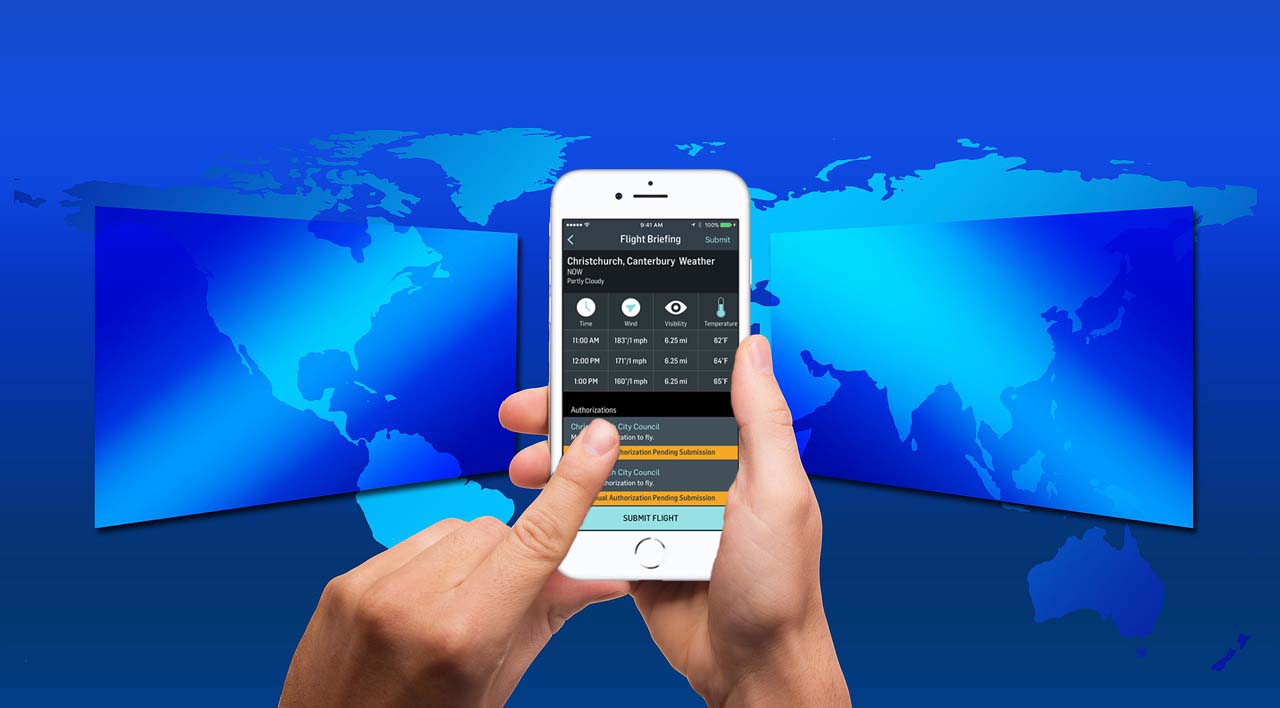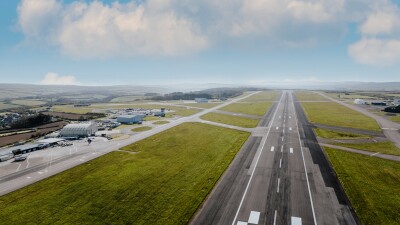We’ve talked a lot about the potential drones have when it comes to changing the way specific construction companies and surveyors can approach a given task, and the commercial ramifications of the technology are incredibly exciting. However, drones are set to enable changes at an even more fundamental level, and AirMap is one of the companies dedicated to ensuring this happens in a safe manner across the world.

Ben Marcus, CEO of AirMap
As the co-founder and CEO of AirMap,
Ben Marcus is particular focused on the company’s mission to make drones part of everyday life. That’s something they’re doing by building
an incredibly powerful airspace services platform, but the logistics of doing so mean collaborating with a variety of partners, sorting through distinctions between a UTM system and U-space, and figuring out what it will take to see drones become a big, scalable business. As you can imagine, this process has put AirMap at the forefront of technology and regulatory developments that are redefining what it does and will mean to operate drones for a variety of purposes.
We connected with Ben to gain a better understanding of what these changes might look like and what sort of impact they’re set to enable, and he was kind enough to answer every single one of the questions we threw out to him. Find out what makes the commercial opportunities being presented by drone technology in 2018 especially unique, what sort of impact commercial specialization will play for the drone industry, how he responds to anyone who thinks a UTM system isn’t any of their concern and plenty more.
Jeremiah Karpowicz: Before we go into detail about a few different terms and systems, I wonder if you could give us a quick primer around a few of them. For anyone who doesn’t have a full grasp on the distinctions, can you briefly tell us what we need to know about LAANC, UTM and U-space? How are these terms/systems interrelated?Ben Marcus: Clearly, we’re fond of acronyms in the drone ecosystem!
Let’s start with UTM. Unmanned aircraft systems Traffic Management, or UTM, is the regulatory and technological framework that will allow drones to safely integrate into low-altitude airspace. It is the infrastructure that allows drones to understand conditions in the world around them and exchange information with other drones, manned aircraft, airspace managers, and other stakeholders. (UTM can also refer to the NASA UTM initiative, which is providing significant leadership that informs efforts to make UTM a reality all over the globe.)
U-space is a similar concept. It is Europe’s vision for unmanned aircraft systems traffic management. It is the digital infrastructure that will support safe, efficient, and secure access to European airspace for millions of drones. U-space is a collaborative effort to enable situational awareness, data exchange, and digital communication for the drone ecosystem in Europe that is championed by the European Commission, SESAR, and EASA. The
U-space Blueprint is a great resource to learn more.
The FAA’s LAANC initiative is a collaborative effort between industry and government to enable digital authorization for flights in controlled airspace. Before LAANC, waivers to fly in controlled airspace could only be obtained through a lengthy application process that can take up to 90 days. Now, drone operators can use AirMap to request digital authorization to fly in controlled airspace surrounding 46 airports, and more than 500 more airports are on their way this year.
We asked Sebastian Babiarz about whether or not U-space was going to get switched on in Europe to open up the skies for commercial drone operators across the continent, but how will those developments in Europe impact what’s happening with the UTM in the United States? More collaboration and more competition will be an important catalyst for UTM in the U.S. and worldwide. The U.S. emerged as an early leader in efforts to open the skies for drones, but there are many more players in 2018. That’s great news for the drone ecosystem.
We’re seeing exciting progress in Switzerland, New Zealand, Japan, Singapore, Germany, and the United Kingdom, to name a few. While there is a certain amount of competition at work in this community, there is also a tremendous spirit of collaboration. These and other countries are joining international forums to share what they’ve learned, and as we share knowledge across borders, the entire drone ecosystem benefits and innovates. I suspect that as other countries invest in unmanned aircraft systems traffic management, their learnings will be reflected in the UTM system being developed in the U.S. – and vice versa.
Are all of these efforts directly or indirectly tied into the work that NASA is doing to define and enable a UTM system for drones? All of these efforts are part of a global movement to open the skies for drones and safely integrate unmanned aircraft into an already crowded airspace. NASA set the tone for all of the work and innovation currently underway, and continues to contribute important guidance as its UTM research evolves.
The expansion of LAANC in the United States is set to be one of the biggest developments in 2018, and you mentioned how significant that will be since it will enable more and better commercial use cases for drones. Do you believe this expansion will compel organizations that were skeptical about the technology to take a close look at it and try it out for themselves? The LAANC prototype has already opened thousands of square miles of controlled airspace for commercial drone flight. The LAANC beta, expected to launch this spring and add more than 500 airports to LAANC over the course of the year, will be another important boost for the drone industry. To date, the biggest barrier to the drone economy has been the gap between what drones can do and what they are allowed to do. The LAANC program could open more than 75,000 square miles of airspace for drone flight in more than 3,900 cities. That means commercial drone operations can not only take off, but can also scale.
I think that’s when we’ll see big enterprises really take notice, and fully implement drone programs that are now in their infancy.
Can you talk a little bit about how partnerships like the one you recently formed with Airways will help in terms of figuring out what might be possible with the UTM?We’re very proud of our work with Airways in New Zealand. Now, drone operators can request airspace approvals required by New Zealand’s Civil Aviation Authority in the areas surrounding Christchurch, Queenstown, and Wanaka airports, and on public lands in the Christchurch City, Selwyn, and Queenstown Lakes District Councils. New Zealand authorities are using the AirMap airspace management dashboard to approve flight plans and share real-time updates with drone operators about the location of events, community gatherings, emergencies, and more. This information is published immediately to the AirMap platform so that drone operators can plan safer flights and stay up-to-date on changing airspace conditions before and during their missions.
These services will be a critical part of the UTM systems that will be deployed all over the world in the near future. With trials like these, we learn which services are most critical for drone operators and airspace managers, how to make the system easy for everyone to use, what operational challenges we must solve for, and how to improve our technology so that more airspace can be open for business.
With the New Zealand trial and similar initiatives in Switzerland, Japan, and other countries, AirMap continues to refine our platform and ensure that we can offer a truly global solution for the drone ecosystem.
Making drones part of everyday life is part of the AirMap mission, so I imagine you see developments like these as a direct path toward that goal?Absolutely. Take our trial with Airways, for instance. Participating test sites have seen an 11x increase in daily drone flights. It’s clear that drone operators and commercial enterprises are eager to enter the airspace, and when we unlock these opportunities with UTM, we’ll see more drone commerce that benefits us in our daily lives.
What role do you see a UTM system playing in terms of seeing or enabling drones to be part of everyday life? Will it be possible to reach this goal without a UTM?From package delivery to flying cars, we’re moving quickly towards this future; UTM is what will make it possible, enabling drones to safely share the skies through communication, data exchange, and deconfliction. It’s the fundamental foundation of a thriving drone economy that is efficient, reliable and sustainable, even at a very high scale.
You mentioned that this partnership allows you to demonstrate how UTM technologies can safely open the skies to high-scale drone operations in the present. Is this something that needs to be proven from a technology standpoint, or from a regulatory one? I think we have the fundamental UTM technology we need to begin opening the skies for more sophisticated drone operations. And as we prove that, regulators will have the confidence they need to allow these missions to become a routine part of our everyday lives.
One of the things I hear from some professional drone operators anytime I mention UTM systems is that it’s a concept they don’t concern themselves with, because it doesn’t directly impact them. What would you say to a commercial operator who felt this way?I get that. I think UTM is still a fuzzy concept to many drone operators because they don’t realize that it is already part of their lives. In a way, UTM is a concept like the internet – there are lots of components that do lots of different things and people don’t really think about the details of what’s going on in the backend to deliver some service to you. When you order an Uber on your mobile phone, do you give any thought to all of the data that has to flow back and forth between your phone, servers, and the driver’s phone, the physical infrastructure like fiber and cell towers that are being employed, and the protocols like URLs, DNS, and IPs being used? No – you just think – “Wow. This is awesome. A private car is about to pick me up.”
UTM is already deployed but it’s in its infancy and it’s going to become way more robust and feature-rich over the coming years. When you use AirMap to review an airport facility map provided by the FAA, it is the result of data exchange that is an important part of the UTM concept. When you request LAANC authorization in the AirMap app to fly at San Jose International, you’re already using a service that should be considered an early feature of UTM. When you get a traffic alert from the AirMap app, you’re seeing an alert that one day could come directly from the airspace manager through UTM integration. You probably interact with a potential UTM service every time you fly. And as more UTM services are implemented, you’ll see the evidence in the thousands of square miles of new airspace where you’re able to fly.
On the recent episode of the 20VC podcast, you mentioned that we have a long way to go before drones are a big scalable business, and that navigation and connectivity were two of the key enablers we need to see for this scalable business transition to take place. Ultimately, will that transition be more about the development of new technologies/approaches to navigation and connectivity, or figuring out how what we already have need to work with drones from a logistical and regulatory perspective? It’s a bit of both. Technologies are developing at a rapid pace and need to continue maturing. For example, the high-bandwidth and high-reliability 5G technology is basically ready, but the network needs to be built and turned on. Logistics and regulations are the gating factor for 5G at this point. On the navigation side, many technologies are in their early development phases and need investment and effort in order to be dependable and useful. For example, the concept exists for high-fidelity wind models that take account of eddys that could form around buildings beneath the boundary layer and provide forecasts at street-block grid density and 10 meter height stratification. However, a lot of work still has to be done to operationalize this kind of capability, which will be very useful for planning routes for highly-automated drones.
How will commercial specialization play a role in this scalable business transition for the drone industry? We’re already seeing many business models emerging. The industry can be split up by vertical use cases and horizontal capability layers. A good argument can be made for specialization in any one of those vertical use cases or horizontal capability layers. For example, to derive useful insights for farmers and create real value for agriculture, service providers need to understand agronomy well. If you’re delivering insights for construction, you need to understand the design and construction process, building information management systems, and so forth. It would be difficult for one company or individual to have sufficient expertise in both agriculture and construction to provide high-value services to both types of customers. On the horizontal capability front, AirMap is an example of a company focused on delivering a component that is valuable across lots of use cases – access to the airspace. The airspace management platform is our strength. It would be difficult for us to also be strong in other horizontal capabilities, like building drones or cameras.
Speaking of regulation, the White House has taken steps to provide states with more authority when it comes to permitting drones to operate in ways currently restricted by the FAA. Opinions about whether or not this is a good thing for the industry vary a great deal, but what are some of the practical ramifications of this development for commercial operators? With the UAS Integration Pilot Program, selected states and cities will be able to open their airspace for sophisticated drone operations that simply can’t take place today - allowing the drone industry to prove that these missions can be flown safely, securely, and efficiently with the technology already available. My hope is that the IPP will prove that we can accelerate our timeline for routine operations in controlled airspace, at night, beyond visual line of sight, and with higher degrees of autonomy and complexity. Practically, that will mean that drone operators will be able to fly more missions, in more airspace, for more commercial purposes, much sooner than we expected before the IPP was announced. That’s when our industry can really take off.
People often talk about “now” being the best time to look at and consider drone adoption, but that will be just as true in the future as it is the present. What makes the commercial opportunities being presented by drone technology in 2018 especially unique or lucrative? In 2018, we’ll get our first look at how a truly scalable drone economy will transform our lives, which makes this a particularly interesting moment for the drone industry. LAANC will continue to expand and we will see it at airports nationwide in the U.S. by the end of the year. Our country’s controlled airspace will finally be open for business, setting off a wave of commercial activity across the country. At the same time, the UAS Integration Pilot Program will start to come to life, enabling new use cases for drones, and similar efforts will get off the ground all over the world. In some areas, drone deliveries by retailers like Amazon, Target and Walmart will start to become routine. Enterprises will scale their fleets and their drone programs, and flying cars will make their first test flights. It’s going to be a pretty incredible year for drones and unmanned aircraft.
What kind of risks are professionals exposing themselves to if they hold off on looking at drone technology until things like regulation and the UTM are more “settled?” There’s still time to make the most of the first mover advantage with drones. My advice for enterprises considering drones: Don’t wait. Find a great technology partner. Identify early use cases. And experiment! This is an important innovation cycle that you need to be in front of.
Operators can’t afford to wait, either. Get your Part 107 certification. Practice your craft. Explore the market, develop your niche, and as much as possible, build your experience, so you can seize the opportunities that are coming your way in 2018 and beyond.

















Comments